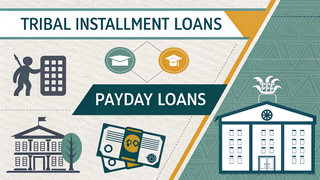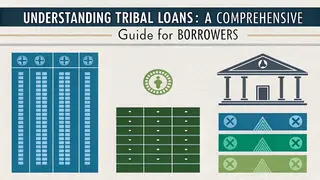Table of Contents
- Introduction
- Understanding Tribal Lenders: The Basics
- Key Verification Factors
- Transparency and Disclosure Practices
- Evaluating Loan Terms and Conditions
- Customer Service Standards
- Online Reputation and Reviews
- Red Flags to Watch For
- Industry Associations and Standards
- Data Security and Privacy Practices
- Pre-Application Checklist
- Conclusion
Introduction
When facing financial challenges, tribal installment loans can provide a viable option for many borrowers, particularly those with limited access to traditional banking services. However, not all tribal loan providers operate with the same level of integrity, transparency, or commitment to fair lending practices. Selecting a reputable tribal loan provider is crucial for ensuring a positive borrowing experience and avoiding potential pitfalls associated with less scrupulous lenders.
This comprehensive guide outlines the essential factors to consider when evaluating tribal loan providers. We'll explore verification methods, transparency standards, loan terms, customer service expectations, and warning signs that might indicate a less trustworthy lender. By understanding these key elements, you'll be better equipped to make an informed decision and select a tribal loan provider that meets your financial needs while operating with integrity and fairness.
Understanding Tribal Lenders: The Basics
What Makes a Lender "Tribal"?
Tribal lenders are financial entities owned and operated by Native American tribes on tribal land. These businesses function under the sovereign immunity of their respective tribes, which creates a unique regulatory environment compared to state-licensed lenders. A genuine tribal lender:
- Is wholly owned by a federally recognized tribe
- Operates under tribal law
- Functions on tribal land
- Benefits the tribal community through economic development
Regulatory Framework
While tribal lenders operate under tribal sovereignty, reputable providers still adhere to federal consumer protection laws, including:
- Truth in Lending Act (TILA) - Requiring clear disclosure of loan terms
- Fair Debt Collection Practices Act (FDCPA) - Governing debt collection practices
- Electronic Fund Transfer Act (EFTA) - Protecting electronic transactions
Understanding this unique position helps borrowers recognize why tribal loans differ from other short-term lending options and why verification of a lender's legitimacy is especially important in this sector.
Key Verification Factors
Tribal Affiliation Verification
Before applying with any tribal lender, verify their legitimate tribal affiliation:
- Check for clear identification of the specific federally recognized tribe that owns and operates the lending operation
- Look for detailed information about the tribal connection on the lender's website, including the tribe's location and governing authority
- Verify the tribe is on the Bureau of Indian Affairs' list of federally recognized tribes
- Be wary of vague references to tribal connections without specific details
Licensing and Authorization
Legitimate tribal lenders operate under formal tribal authorization:
- Look for tribal lending authority documentation, often referenced on the lender's website
- Check for tribal lending codes or ordinances that govern the lender's operations
- Verify the lender has a physical address on tribal land, not just a P.O. box
Legal Operating History
Research the lender's history and legal standing:
- Check how long the lender has been in operation - established lenders with multi-year histories tend to be more reliable
- Search for any legal actions against the lender using resources like the Consumer Financial Protection Bureau's complaint database
- Investigate any news coverage or reports about the lender's business practices
Transparency and Disclosure Practices
Clear Rate and Fee Disclosures
Reputable tribal lenders provide transparent information about their costs:
- APR (Annual Percentage Rate) disclosure - clearly stated before you apply
- Breakdown of all fees - including origination fees, late payment fees, and any other charges
- Sample repayment schedules showing how interest and principal are allocated in each payment
- Total cost of the loan clearly stated for various loan amounts and terms
Loan Agreement Accessibility
Before committing to a loan, check if the lender provides:
- Access to full loan agreements before application submission
- Plain language explanations of key terms and conditions
- Clear answers to questions about loan terms when asked
- No pressure tactics to sign before reviewing all documents
Website Transparency
Evaluate the lender's website for transparency indicators:
- Complete contact information including physical address, phone number, and email
- Detailed "About Us" section explaining tribal ownership and operations
- Accessible FAQ section addressing common questions about tribal lending
- Clear privacy policy explaining how your information will be used and protected
The most reputable tribal lenders emphasize transparency in all aspects of their operations, making it easy for borrowers to make informed decisions without hunting for essential information.
Evaluating Loan Terms and Conditions
Interest Rates and APR
When assessing tribal loan costs:
- Compare APRs across multiple lenders - tribal loan APRs typically range from 200% to 700%, but the best lenders offer competitive rates within this range
- Understand how interest is calculated - simple interest is generally more favorable than compound interest
- Check for rate caps that limit the maximum APR charged
- Be cautious of rates that seem significantly higher than industry averages without clear justification
Repayment Structure
Evaluate the loan's repayment terms:
- Verify the loan is truly installment-based with scheduled payments that reduce principal over time
- Check payment frequency options - bi-weekly or monthly payments should align with your pay schedule
- Understand the loan term length - typically ranging from a few months to several years
- Look for amortization schedules showing how each payment is applied to principal and interest
Flexibility Features
Reputable lenders offer borrower-friendly features:
- Early repayment options without penalties
- Grace periods for late payments before penalties apply
- Payment deferment or modification options in case of financial hardship
- Clear processes for payment changes or loan adjustments
Default Consequences
Understand what happens if you can't repay:
- Review late payment fees and how they're calculated
- Check if and when the lender reports to credit bureaus
- Understand the collection practices the lender uses
- Look for hardship programs or workout options for struggling borrowers
Customer Service Standards
Accessibility
Evaluate how easily you can reach the lender:
- Multiple contact channels including phone, email, and live chat
- Extended customer service hours that accommodate different time zones
- Responsive social media presence or support options
- Toll-free phone numbers to minimize communication costs
Pre-Application Support
Test customer service before applying:
- Call with specific questions about loan terms or application requirements
- Evaluate response time to emails or contact form submissions
- Assess representatives' knowledge and willingness to explain complex terms
- Note whether representatives pressure you to apply or simply provide information
Account Management Features
Look for convenient borrower tools:
- Online account portal for payment management and loan information
- Mobile-friendly website or dedicated app
- Automatic payment options with clear enrollment and cancellation procedures
- Online access to statements and payment history
Quality customer service indicates a lender's commitment to positive borrower relationships and should be a significant factor in your decision-making process.
Online Reputation and Reviews
Consumer Review Sources
Thoroughly research lender reviews across multiple platforms:
- Check specialized review sites like Trustpilot, Better Business Bureau, and Consumer Affairs
- Read social media feedback on platforms like Facebook, Twitter, and Reddit
- Search for forum discussions in financial communities
- Look beyond star ratings to read specific comments about borrowers' experiences
Common Complaint Patterns
Pay attention to recurring issues in negative reviews:
- Hidden fees not disclosed before loan finalization
- Aggressive collection practices or harassment
- Difficulty contacting customer service after receiving funds
- Technical problems with payments or account access
- Unauthorized withdrawals or incorrect payment processing
Company Responses
Evaluate how the lender interacts with reviewers:
- Check if the company responds to both positive and negative reviews
- Assess the tone and helpfulness of responses to complaints
- Note if they offer solutions or simply defend their practices
- Look for patterns of resolution following customer complaints
Regulatory Complaints
Research official complaints and regulatory actions:
- Check the CFPB complaint database for formal complaints
- Research any state attorney general actions against the lender
- Look for news about regulatory investigations or settlements
- Review Better Business Bureau rating and complaint history
Red Flags to Watch For
Aggressive Marketing Tactics
Be cautious of lenders that use high-pressure techniques:
- Unsolicited loan offers via email, text, or phone
- Countdown timers or "limited time" offers creating false urgency
- Guaranteed approval claims without credit check requirements
- Pushy representatives who discourage comparison shopping
Questionable Business Practices
Watch for these warning signs of potentially problematic lenders:
- Upfront fees required before loan funding
- Requests for payment via gift cards or wire transfers
- Vague or missing information about the tribal affiliation
- No clear physical address on tribal land
- Website security issues including non-secure connections for application pages
Contract Red Flags
Be wary of problematic terms in loan agreements:
- Mandatory arbitration clauses that severely limit your legal rights
- Auto-renewal provisions that continue the loan automatically
- Excessive penalties for early repayment
- Unclear or hidden fees buried in fine print
- Wage assignment clauses giving direct access to your paycheck
Customer Service Warning Signs
Poor service indicators to watch for:
- Unresponsive pre-loan inquiries - if they're hard to reach before you borrow, it will likely be worse afterward
- Evasive answers to direct questions about terms or costs
- Pressure to sign immediately without reviewing all documents
- Unwillingness to provide written documentation of terms
Industry Associations and Standards
Tribal Lending Organizations
Look for membership in recognized industry groups:
- Native American Financial Services Association (NAFSA) - Established organization that promotes responsible lending practices among tribal lenders
- Online Lenders Alliance (OLA) - While not specific to tribal lenders, membership indicates commitment to industry best practices
- Other tribal economic development organizations that promote responsible business practices
Best Practice Standards
Reputable tribal lenders adhere to industry standards:
- Transparent disclosure of terms and conditions
- Fair collection practices that avoid harassment
- Responsible lending that considers borrower ability to repay
- Data security protocols that protect consumer information
- Educational resources to help borrowers make informed decisions
Certification and Compliance
Check for indications of rigorous standards:
- Compliance statements regarding federal consumer protection laws
- Security certifications for website and data handling
- Transparency regarding tribal economic development contributions
- Clear code of conduct or customer service commitments
Data Security and Privacy Practices
Website Security Indicators
Verify the lender's website security measures:
- Secure connection (HTTPS) throughout the entire website, especially on application pages
- Valid SSL certificate with proper encryption
- Security trust seals from recognized security verification companies
- Two-factor authentication options for account access
Privacy Policy Review
Carefully review how your information will be handled:
- Clear explanation of what personal information is collected
- Specific details about how your information is used
- Information sharing practices with third parties
- Opt-out options for marketing communications
- Data retention policies indicating how long information is kept
Data Breach History
Research the lender's track record with sensitive information:
- Search for news about any past data breaches
- Review how the company responded to any security incidents
- Check if they notify customers promptly about security concerns
- Look for mentions of regular security audits or assessments
Given the sensitive financial and personal information required for loan applications, strong data security practices are non-negotiable when selecting a reputable tribal lender.
Pre-Application Checklist
Before submitting an application to a tribal lender, complete this essential verification checklist:
- ✓ Verified tribal ownership - Confirmed the specific federally recognized tribe that owns and operates the lender
- ✓ Checked online reviews - Researched customer experiences across multiple platforms
- ✓ Confirmed clear rate disclosure - Found and understood the complete APR and fee structure
- ✓ Reviewed sample loan agreement - Examined all terms and conditions before applying
- ✓ Tested customer service - Made contact to evaluate responsiveness and helpfulness
- ✓ Verified secure application - Confirmed proper website security for transmitting personal information
- ✓ Checked for red flags - Evaluated for warning signs like upfront fees or aggressive tactics
- ✓ Confirmed repayment options - Understood payment schedules and methods
- ✓ Researched company history - Looked into how long the lender has been operating
- ✓ Reviewed privacy policy - Understood how personal information will be handled
Taking the time to complete this checklist can significantly reduce the risk of selecting an unscrupulous lender and help ensure a more positive borrowing experience.
Conclusion
Selecting a reputable tribal loan provider requires careful research and attention to detail, but the effort is well worth it to ensure a fair and transparent borrowing experience. While tribal loans often come with higher costs than traditional bank products, a responsible tribal lender will provide clear terms, reasonable repayment structures, and excellent customer service.
Remember that the most important factors to consider include verified tribal affiliation, transparent cost disclosures, reasonable loan terms, positive customer reviews, strong data security, and responsive customer service. Be particularly vigilant about red flags such as upfront fees, aggressive marketing tactics, and vague tribal connections.
By taking the time to thoroughly evaluate potential lenders using the criteria outlined in this guide, you can significantly reduce the risk of dealing with predatory or deceptive lending practices. A reputable tribal lender will welcome your questions, provide clear information, and demonstrate a commitment to responsible lending that benefits both borrowers and the tribal community.
Ultimately, the right tribal loan provider should offer a product that meets your immediate financial needs while treating you with respect and transparency throughout the entire borrowing process. With proper due diligence, tribal installment loans can be a viable alternative for many borrowers seeking access to credit.




